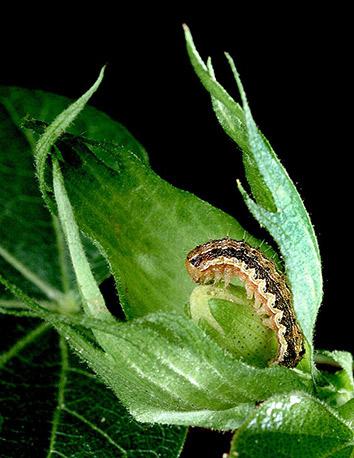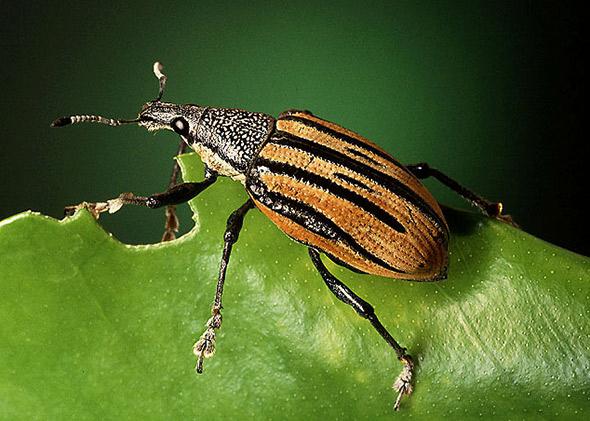We are losing the war on bugs. Every year, we dump 1 billion tons of insecticides on them; every year, they eat up to a fifth of the crops we grow. It’s a lose-lose scenario. Insecticides are expensive to make and use: Apple trees, for example, must be sprayed 20 times a year. Poisons have side effects: sick farmworkers, nightmarish industrial accidents, even the die-off of butterflies and bees. Eventually, pests evolve and become resistant to the pesticides, and they stop working.
There is another way. It involves listening to plants, which have fought this battle much longer than we have.
When a caterpillar or a beetle starts chewing on a leaf, the plant responds by synthesizing its own defense chemicals in an attempt to drive away the insect. It also releases a chemical plume into the air, a message that can be intercepted by creatures nearby. Other plants respond to these alerts by producing their own chemical weapons, substances that repel leaf-eating insects. Predators that eat plant pests also detect the signals, using them like beacons to locate their prey.
This chatter is going on all the time, all around us. A moth or wasp or a bird flitting through a field is barraged by constant status updates about which plants and creatures are nearby and what they’re up to. It’s the biggest and most important conversation on Earth. But until recently we had no idea it was happening, since human noses can’t detect most of these chemical communiqués. (The scent of cut grass is one exception. To us, it smells like summer, but to other plants, it’s a warning that something is attacking.)

Courtesy of Scott Bauer/USDA
The first evidence that plants might be able to communicate with one another came in 1983, with a study exploring the defense mechanisms of willow trees. When one willow tree’s leaves got chewed up by caterpillars, researchers discovered, not only that tree but also willows nearby began synthesizing compounds to fend off bugs. It was an amazing find: Somehow, trees could share information, without ears, eyes, or brains. And it soon turned out that most, if not all, plants can send and receive these airborne chemical signals.
Cracking the plant code offers a new opportunity for our agricultural future. Researchers who study plant signals now foresee an era in which crops can identify pests, deploy natural bug-deterring compounds, and summon their own bug-eating bodyguards—all without toxic chemicals.
“We can’t feed the world with this technology at the moment,” says chemist John Pickett, one of the pioneers of this work. “But we’re not going to be able to feed the world tomorrow with today’s technology.”
To reach this future, we will have to reconceptualize the war on bugs. Now, we treat it like a conventional war, where the way to win is to make more and deadlier weapons to kill more opponents. We have to start thinking about it like a war of intelligence, won by spying on our enemies and using their own codes to trick and defeat them.
The first step will be mastering the language. Plants can make thousands of volatile compounds, and just one emission may blend more than 200 different chemicals. Sending the wrong message could be a disaster: In one study, corn plants treated with some volatile compounds actually became more attractive to armyworms and cucumber beetles.
Using techniques like gas chromatography to separate out individual compounds, Pickett’s team at Rothamsted Research in the United Kingdom is identifying several volatile chemicals that many plants respond to, such as cis-jasmone. Well-known in the perfume business, cis-jasmone is partly responsible for the intense sweetness of jasmine flower, but it also works as a signal to activate plant defenses. When Pickett sprayed synthetic cis-jasmone on plants ranging from soybeans to cotton, they began producing compounds to repel aphids and other bugs.
Plants aren’t the only ones listening to these messages. Predatory bugs and caterpillar parasites sniff out the emissions of a plant being eaten, and like Batman responding to a bat signal in the night sky, swoop in for the rescue. Lima bean plants infested with sap-sucking spider mites attract predatory mites this way, chemical ecologist Marcel Dicke of Wageningen University in the Netherlands discovered. He and others are working to identify which insects respond to which chemicals. Their go-to technique involves cutting the antennae off of predatory insects, wafting plant emissions over the disembodied antennae, and using electrodes to monitor the electrical responses of odor-sensing cells. They have compiled a long list of creatures that recognize plant distress calls, including thrips, predatory stink bugs, beetles, ladybirds, tiny wormlike nematodes, parasitoid wasps that lay their eggs on caterpillars, and even birds.
Pickett, Dicke, and a few other teams around the world want to use this knowledge to teach our crop plants the lost art of self-defense. Many of the plants we grow for food have been bred for generations to taste or look good and along the way have lost their ancestral communication skills. The highly inbred strains of corn commonly grown in the United States no longer respond to signals, but varieties preferred by farmers in other parts of the world still have the knack. Their genes could be reintroduced to commercial crops. Dicke has identified one strain of cucumber that’s twice as good as the usual Dutch commercial varieties at attracting predatory mites, and he hopes to breed this ability back into the plant.

Courtesy of Scott Bauer/USDA
Real-world proof that this strategy can work comes from a project running since 1995 in Kenya and neighboring parts of East Africa, where moth larvae called stem borers eat up to 80 percent of the corn crop. Under the “push-pull” system developed by the International Center of Insect Physiology and Ecology in Kenya in collaboration with Rothamsted Research, farmers use signaling plants to fool larvae into staying off their crops.
For the “push,” they plant a shrubby cloverlike plant called desmodium in between the corn or sorghum plants. Its emissions repel stem borers, keeping them away from the grains. The “pull” comes from Napier grass, which attracts moths looking to lay their eggs, planted around the edge of the field to keep the moths away from the corn. Molasses grass, whose signals summon tiny parasitic wasps that destroy stem borer larvae, can also be planted among the corn as an added weapon. According to ICIPE, more than 75,000 smallholder farmers now follow this system, which can triple their yields.
This system could be adapted to many parts of the world where small-scale farmers customarily plant several plants together. But what about American- or Canadian-style intensive farming, where enormous yields are made possible by machines, monocrops, and insecticides?
Simply spraying crops with chemicals to attract predators of agricultural pests won’t work, says Martin Heil, an ecologist at the Mexican research institute CINVESTAV Irapuato who studies plant-insect signaling. It could crash the whole system. At first, predatory bugs would swarm around a plant that seems to be calling for help. But if the plant is crying wolf, and there are no juicy bugs to be found, the predators will either move on or starve to death.
“Reliable, honest information is crucial,” Heil says. He is working on another way to feed predatory insects that visit crop plants, by cultivating varieties that naturally produce nectar from their stems and leaves, a treat that meat-eating bugs particularly enjoy.
Breeding plants to be better communicators is just one of the ideas inspired by the science of plant signaling. Genetically engineered sentinel plants could be stationed in fields like canaries in the coal mine—the first to get attacked and the first to raise the alarm, so valuable crops get a head start on making their own defenses. Crops that naturally produce pest-attracting volatiles could instead be genetically silenced, a way of cloaking them so that the bugs don’t even know they’re there.

Courtesy of Scott Bauer/USDA
But for a pest-control strategy based on information to work, agriculture is going to have to become smarter. The communication triangles among plants, pests, and predators must be fully understood. Timing is also key: Predatory bugs need to be persuaded to show up early, before pests do much damage.
The transition from killing bugs to deceiving them may happen only under duress—when pesticides stop working or become too expensive to use, or if consumers revolt. Dicke points to a case in the Almeria region of Spain, where tomato and pepper growers were using illegal pesticides in their greenhouses until the Germans got wind of it in 2006. Overnight, European markets stopped buying Spanish peppers, and growers were forced to switch to a method that relies on insect predators instead.
Now all the peppers in the region are grown this way, as well as most of the cucumbers and melons—and pretty successfully. In a survey, 97 percent of growers said biocontrol worked better than chemical pesticides, Dicke says. “This option can replace chemicals to a large extent,” he says. “It needs this mind shift of saying, ‘We can do things without chemicals. What everyone says is impossible is possible.’ ”
It’s a plant’s world—we just live in it. So figuring out how they detect their enemies and recruit their protectors may truly be our best chance at reclaiming our lost harvests. By understanding how the crops that feed us deploy their own defenses, we can help them get better at it. We can turn plants into our allies—simply by learning to speak their language.
